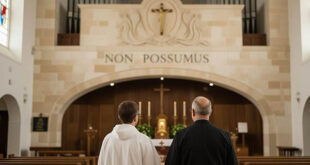The word “anathema” often evokes strong reactions, frequently associated with condemnation or exclusion in a religious context. However, its meaning and use within Catholic tradition are far deeper and richer than they might initially seem. Throughout Church history, the concept of “anathema” has played a crucial role in defending the faith, correcting doctrinal errors, and protecting the integrity of the Christian message.
In this article, we will explore the historical and theological meaning of anathema, its role in councils and ecclesial declarations, and how this concept can still offer valuable lessons for our spiritual lives today. Although the formal use of the term has evolved over time, its essence remains relevant for all believers seeking to live in communion with authentic Catholic faith.
What is Anathema?
The term “anathema” comes from the Greek ἀνάθεμα, which originally meant “offering” or “something dedicated to God.” In a broader sense, it could refer to something set apart or consecrated for worship. Over time, this concept developed, taking on a more severe connotation in Christian history. In the early centuries of the Church, “anathema” came to denote not only a form of consecration but also a solemn excommunication—a type of ecclesiastical judgment that involved excluding someone from the community of believers due to a serious doctrinal deviation.
St. Paul, in his letters, uses the term in a context that highlights its gravity. In Galatians 1:8-9, Paul declares: “But even if we or an angel from heaven should preach to you a gospel contrary to the one we preached to you, let him be anathema.” Here, “anathema” means a separation from the body of the Church for those who preach heresies or distort the Gospel of Christ.
In the Catholic context, anathema has a more solemn implication: it represents the formal condemnation of heresy by the Church. Throughout the ecumenical councils, especially in the early centuries, anathemas were employed to clarify correct doctrines and separate those who persisted in teaching serious errors.
Anathema in Church History
The Ecumenical Councils and Anathema
Anathema became prominent during the early ecumenical councils of the Church, such as the Council of Nicaea (325), where the teachings of Arius, who denied the divinity of Christ, were condemned. The council proclaimed that those who denied Christ’s consubstantiality with the Father would be “anathema.” This condemnation not only protected doctrinal truth but also aimed to preserve the unity of Christian faith in the face of heresies that threatened to fracture it.
Later, at the Council of Ephesus (431) and the Council of Chalcedon (451), similar anathemas were issued against Nestorianism and Monophysitism, doctrines that distorted the correct understanding of Christ’s nature as both fully divine and fully human.
Anathemas were not simple declarations of rejection; they were solemn and issued after careful theological discernment and debate. The Church, in its love for truth, sought to correct error and protect authentic faith, always hoping that those who strayed from the truth would repent and return to full communion.
The Council of Trent and Anathemas
One of the most significant moments in the more recent history of anathemas was the Council of Trent (1545-1563), convened in response to the Protestant Reformation. During this council, the Church addressed many teachings that had been questioned by the reformers, such as the nature of the sacraments, justification, and the authority of Tradition. The council’s declarations contained numerous anathemas against those who denied the doctrines defined by the Church.
For example, in the decree on justification, the council declares: “If anyone says that men are justified either by the sole imputation of the justice of Christ or by the sole remission of sins, to the exclusion of the grace and charity which is poured forth in their hearts by the Holy Ghost and is inherent in them, let him be anathema” (Canon 11). These statements emphasized the necessity of fully accepting the Church’s teachings to remain in communion with it.
Anathema and Its Theological Significance
Anathema should not be seen merely as a punitive condemnation but rather as an act of protecting the faith community and safeguarding the truth. When the Church proclaims an anathema, it does so with the hope of correcting error and inviting repentance and reconciliation. In fact, the ultimate goal of anathema is not permanent exclusion but the restoration of communion.
Theologically, anathema is based on the conviction that truth is essential for salvation. Jesus Christ Himself declared that He is “the way, the truth, and the life” (Jn 14:6), and that knowing the truth sets us free (Jn 8:32). Therefore, defending the truth is an act of charity, as doctrinal errors can lead people away from life in Christ.
What Does Anathema Mean Today?
In modern times, the Church has softened its use of terms like “anathema” in official declarations, especially since the Second Vatican Council. However, the spirit behind the teachings related to anathema remains relevant. In a world where many ideas compete for the truth and where personal beliefs can deviate from orthodox teaching, the concept of anathema invites us to reflect on the importance of truth and fidelity to the Catholic faith.
Today, anathema challenges us to carefully discern what we believe and how we live out those beliefs. It calls us to radical fidelity to the Church’s teachings and to a life of spiritual integrity. Instead of seeing anathema as external judgment, we can view it as an opportunity to examine our lives and ensure that we are living in full communion with the truth revealed by Christ.
Practical Applications of Anathema in Daily Life
- Discernment of Truth: We live in an age of relativism, where truth is often presented as subjective or personal. Anathema reminds us that truth is objective and that Christ is its source. In our daily lives, we can apply this by actively seeking the truth in our moral and spiritual decisions, relying on the Church’s teachings.
- Fidelity to the Faith: Anathema also challenges us to remain faithful to the teachings of the Church, even when we find ourselves in a world that often contradicts these teachings. Through prayer, the sacraments, and study, we can strengthen our faith and avoid falling into doctrinal errors that may lead us away from the truth.
- Reconciliation and Mercy: While anathema implies separation, its ultimate goal is reconciliation. We can apply this in our personal relationships, always seeking reconciliation and the restoration of communion, even in the face of disagreements or conflicts. Forgiveness and mercy should be our primary responses when we encounter error.
Conclusion
The concept of anathema remains relevant to Christian life in the 21st century, not as a threat of condemnation but as a call to fidelity, truth, and reconciliation. Throughout the Church’s history, anathema has been a tool for protecting the purity of the faith and guiding believers toward deeper communion with God.
In a world marked by pluralism and relativism, anathema invites us to carefully discern what we believe, to stand firm in our faith, and to always seek the truth that offers us freedom in Christ. Through fidelity to the Church’s teachings, we can live with confidence that we are walking on the path of salvation, sustained by God’s grace and the guidance of the Holy Spirit.






